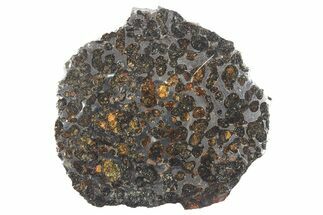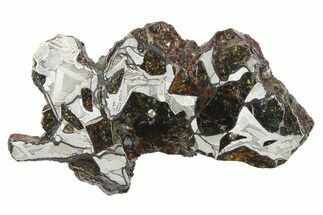1.48" Pallasite Meteorite (8.80 g) Slice - NWA 15428
This gorgeous, 1.48 wide (8.80 gram) slice of a new Northwest African pallasite, NWA 15428 (Provisional). It has been sliced thin and some of the large olivine crystals glow when backlit. It has been fully stabilized to prevent rusting.
Don't miss out, as there is a very limited quantity of material from this meteorite.
Don't miss out, as there is a very limited quantity of material from this meteorite.
About Pallasite NWA 15428 (Provisional)
NWA 15428 is the provisional name for a gorgeous Northwest Africa pallasite that is still pending formal classification. The total known weight of this meteorite is only 1.7 kilograms, so there is very little material on the market. It has very large, dark brown to amber-colored olivine crystals.
NWA 15428 is the provisional name for a gorgeous Northwest Africa pallasite that is still pending formal classification. The total known weight of this meteorite is only 1.7 kilograms, so there is very little material on the market. It has very large, dark brown to amber-colored olivine crystals.
About Pallasites
Pallasite meteorites are a class of stony-iron meteorites. They were once believed to have originated at the core-mantle boundary of asteroids that shattered through impacts, but a recent hypothesis is that they are a mixture of core and mantle minerals.
Pallasite meteorites consist of olivine (peridot) crystals surrounded by iron-nickel matrix. Upon acid etching, some pallasites display interweaving structures known as Widmanstätten patterns (or Thomson lines) in the metallic matrix. These structures are iron-nickel alloy crystals, typically kamacite and taenite, that cooled over millions of years in the vacuum of space.
Pallasites are quite rare: only about 200 are known, and only four have had observed falls. This represents less than 0.2% of all classified meteorites!
Pallasite Care
Pallasites are even more susceptible than most iron meteorites to rusting and deterioration due to moisture in the atmosphere; proper care includes keeping them in moisture-free environments. This is particularly important in areas with high humidity, such as Florida. All pallasite material we sell has been stabilized in some way, which will help with this issue, but care still needs to be taken to keep your treasure in good condition. Keep pallasites stored in a moisture-free environment, preferably with a corrosion inhibitor such as silica gel beads or a dehumidifier.
Pallasite meteorites are a class of stony-iron meteorites. They were once believed to have originated at the core-mantle boundary of asteroids that shattered through impacts, but a recent hypothesis is that they are a mixture of core and mantle minerals.
Pallasite meteorites consist of olivine (peridot) crystals surrounded by iron-nickel matrix. Upon acid etching, some pallasites display interweaving structures known as Widmanstätten patterns (or Thomson lines) in the metallic matrix. These structures are iron-nickel alloy crystals, typically kamacite and taenite, that cooled over millions of years in the vacuum of space.
Pallasites are quite rare: only about 200 are known, and only four have had observed falls. This represents less than 0.2% of all classified meteorites!
Pallasite Care
Pallasites are even more susceptible than most iron meteorites to rusting and deterioration due to moisture in the atmosphere; proper care includes keeping them in moisture-free environments. This is particularly important in areas with high humidity, such as Florida. All pallasite material we sell has been stabilized in some way, which will help with this issue, but care still needs to be taken to keep your treasure in good condition. Keep pallasites stored in a moisture-free environment, preferably with a corrosion inhibitor such as silica gel beads or a dehumidifier.
TYPE
Pallasite (Unclassified)
LOCATION
Northwest Africa
SIZE
1.48 x 1.07", .09" thick, 8.80 grams
CATEGORY
ITEM
#269631
 Reviews
Reviews









